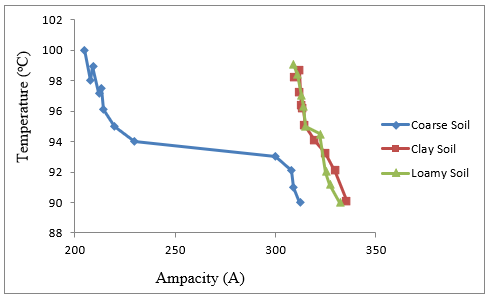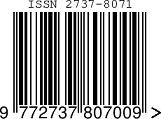The Effect of soil temperature on the ampacity values of underground cables in Jalingo, North – East Nigeria
ampacity values of underground cables in Jalingo
Keywords:
Ampacity, Thermal Conductivity, Backfill, Ambient Temperature, soil, JalingoAbstract
Cables are like bridges that connects the machine that generate electricity and the appliances that uses it. Electrical cable can be a single conductor (solid or stranded) insulated through its full length; or several conductors spread together with each given its insulation under one outer protective covering. Electricity flowing in a conductor generates heat. A resistance to heat flow between the cable and the ambient environment causes the cable’s temperature to rise. This work examined the effect of soil temperature on the current rating of a Cross Link Polyethylene Low Voltage Cable laid in three power substations in Jalingo, Taraba State. The findings revealed a mean soil temperature and ampacity value of 95.25 oC and 245.12 A for coarse soil, 95.06 oC and 318.90 A for clay soil and 94.8 oC and 318.70 A for loamy soils. Comparison of the ampacity values of the different soils with the standard value of 320 A, the current rating of the cable is reduced by 74.88 A, 1.1 A and 1.3 A respectively for coarse, clay and loamy soils. Results also indicated that the current rating of the cables laid on loamy soil is 1.3 times greater than that on coarse soil at their respective temperatures. The study suggested that clay and loamy soil are suitable materials for local backfilling, while coarse soil is not.
Downloads
References
J. H. Neher, et al., Power Cable Ampacities, vol. I—Copper Conductors, AIEE Pub. No. S-135-1, IPCEA Pub. No. P-46-426, New York: AIEE, 1962.
K. Malmedal et al., “The measurement of soil thermal stability, thermal resistivity and underground cable ampacity” in Proc. Rural Electric Power Conf 2014 REPC 2014 pp. C5-1 – C5-12
L.S.Chernobrovkin, Dinamika poleta bezpilotnykh letatelykh apparatov. "Flight dynamics of unmanned vehicles". Mashinostroenie, Moscow 1973.
D. Enescu et al., “Thermal Assessment of Power Cables and Impacts on Cable Current Rating: An Overview,” Energies, vol. 13, no. 20, p. 5319, Oct. 2020, doi: 10.3390/en13205319. [Online]. Available: http://dx.doi.org/10.3390/en13205319
C. Bates et al., “How to include soil thermal instability in underground cable ampacity calculations,” in 2016 IEEE Industry Applications Society Annual Meeting, 2016, pp. 1–8.
F. de Leon, “Major factors affecting cable ampacity,” in 2006 IEEE Power Engineering Society General Meeting, Montreal, Que., Canada, 2006.
A. S. Mickley, “The thermal movement of moisture in soil,” Trans. Amer. Inst. Elect. Engineers, vol. 68, no. 1, pp. 330–335, 1949
A. Lilliestierna, and J. Utas, “Thermal classification of cable route,” Master’s Degree, Chalmers University of Technology, 2015.
G. C. Stevens et al., “High performance thermoplastic cable insulation systems,” in 2016 IEEE International Conference on Dielectrics ICD vol. 1, pp. 272–275, 2016.
T.V.M. Nielsen et al.,. “Dynamic Rating of Three–Core XLPE Submarine Cables for Offshore Wind Farms” Appl. Sci. vol 9 pp 800 – 807, 2019.
C. N. Gerald, “Understanding the Neher-McGrath Calculation and the Ampacity of Conductors” online www.electrician2.com/articles/ampacity.html, 20th September, 2017.
EIC “Electrical Installation Conference, Philadelphia” PA, 2014, PP. 303-306.
C. Zhou et al., “Review of recent research towards power cable life cycle management” High Volt. Vol. 2, pp 179–187 2017.
N. Zhang, and Z. Wang, “Review of soil thermal conductivity and predictive models” Int. J. Therm . Sci. vol. 117, pp. 172–183, 2017.
N. Cyril, and O Difference, “An Investigation of Temperature Variation at Soil Depths in Parts of Nigeria” American of Environmental Engineering vol. 3 pp 142-147, 2002.
K. Murat, K. and Ozcan, “Coupled Electrical and Thermal Analysis of Power Cables Using Finite Element Method, Heat Transfer - Engineering Applications” Prof. `Vyacheslav Vikhrenko (2011) (Ed.), ISBN: 978-953-307-361-3, InTech, Available from:http://www.intechopen.com/books/heat-transfer engineeringapplications/coupled-electrical-and-thermal-analysis-of-power-cables-using-finite-element-method
O. E. Igwe, “Cable Sizing and Its Effect on Thermal and Ampacity Values in Underground Power Distribution”. Theses and Dissertations--Electrical and Computer Engineering (2016). 87p. https://uknowledge.uky.edu/ece_etds/87
J. Pilgrim, P. Lewin, A. Gorwadia, F, Waite, D. and Payne, Quantifying possible transmission network benefits from higher cable conductor temperatures, IET. Gener. Transm. Distrib, vol.7, pp 636-644, 2013.
J. H. Lienhard, A Heat Transfer Text Book. 3rd Ed., Phlogiston Press: Cambridge, Massachusetts 2003.
A. J. George, Rating of Electric Power Cables – Ampacity calculations for transmission, distribution and industrial applications, IEEE Press: New York, 1997
J. H. Neher, and M. H. McGrath, “The calculation of temperature rise and load capability of cable systems, Power App. Syst., Part III” Trans. Amer. Inst. Elect. Eng. Vol. 76 pp 752 – 764, 1957.
IRENA. Innovation Landscape Brief: Dynamic Line Rating; International Renewable Energy Agency: Abu Dhabi, United Arab Emirates, 2020.
A. Safdarian,et al. “Benefits of Real-Time Monitoring to Distribution Systems: Dynamic Thermal Rating”. IEEE Trans. Smart Grid vol. 6, pp 2023–2031, 2015.
P. Chatzipanagiotou, et al., “Influence of soil humidity on the thermal impedance, time constant and structure function of underground cables: A laboratory experiment’ Appl. Therm. Eng. Vol.113, pp 1444–1451, 2017.
S.H. Alwan, et al., “Factors Affecting Current Ratings for Underground and Air Cable” Int. J. Energy Power Eng. Vol.10 pp 1422–1428, 2016.
D. Enescu et al., “Thermal Assessment of Power Cables and Impacts on Cable Current Rating: An Overview”. Energies vol. 13 pp 1 – 9, 2020

Downloads
Published
How to Cite
Issue
Section
License
Copyright (c) 2022 Terkaa Victor Targema, Kanu Maxwell Obia, Gabriel W. Joseph, Anuye Yohanna

This work is licensed under a Creative Commons Attribution 4.0 International License.
Copyright on any article in the International Journal of Engineering and Applied Physics is retained by the author(s) under the Creative Commons license, which permits unrestricted use, distribution, and reproduction provided the original work is properly cited.
License agreement
Authors grant IJEAP a license to publish the article and identify IJEAP as the original publisher.
Authors also grant any third party the right to use, distribute and reproduce the article in any medium, provided the original work is properly cited.














